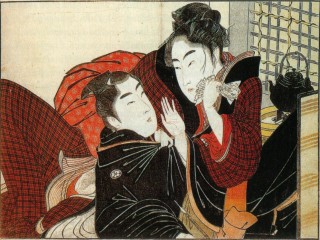
Kitagawa Utamaro biography
Date of birth : -
Date of death : 1806-10-31
Birthplace : Japan
Nationality : Japanese
Category : Arts and Entertainment
Last modified : 2011-10-11
Credited as : Painter, wood-block printing, Ukiyo-e artist
Kitagawa Utamaro (1753-1806), one of the greatest masters of the Ukiyo-e school of Japanese wood-block printing, excelled in the exotic portrayal of Japanese women, especially those of the Yoshiwara district. Many contemporary critics regard him as the greatest Japanese printmaker.
Like most of the wood-block printing, Kitagawa Utamaro was a native of Edo (modern Tokyo). His teacher was Toriyama Sekien, but the greatest influence on him was the work of Kiyonaga, the dominant Ukiyo-e artist of his youth. Utamaro's talent was discovered while he was still very young by the discriminating publisher Tsuta-ya Juzaburo, who brought out many of his prints. The most outstanding of Utamaro's early works are his illustrated books, the finest of which are the albums of insects, shells, and birds published between 1787 and 1791 and reflecting the influence of the Dutch scientific publications which were entering Japan through the port of Nagasaki.
During the 1790s Utamaro reached his artistic peak. Following in the footsteps of Kiyonaga, he portrayed Japanese women, bringing out their grace and elegance. Utamaro's most original contribution to the art of the Japanese print was his close-up pictures, or Okubi-e, which concentrated on the face. He was also the undisputed master of the erotic print, a genre to which he brought all his skill as a draftsman and designer.
Utamaro's career came to an end when he was arrested in 1804 for representing the 16th-century shogun Toyotomi Hideyoshi in a disrespectful manner. Although his imprisonment was brief, he never recovered from this blow, and he died two years later.
It is estimated that Utamaro produced some 1, 500 prints, most of them devoted to celebrating the beauty of the Japanese woman. In fact, he created a special type of female beauty, tall and slender, with an oval face, sharply defined features, slanted eyes, and a tiny mouth. Often published in sets with titles like Ten Facial Types of Women, Love Poems, Flourishing Beauties of the Present Day, The Mirror of Flirting Lovers, Twelve Hours of the Green Houses, and Elegant Amusements of the Four Seasons, these prints show the life of the courtesans and teahouse waitresses of Yoshiwara, the amusement district of Edo. Other famous sets deal with genre scenes such as mothers with children or women engaged in domestic tasks. Most of these works consist of groups of single prints; others are diptychs and triptychs, the set showing the courtesans on the Ryogoku bridge being the most famous in this category. However, his great fame as well as his influence on later printmakers rests above all on his full-face pictures of the Utamaro-type beauties. In these works his sophistication and felling for female physiognomy are most fully expressed.
While Utamaro's subjects by and large were taken from the general repertoire of the Ukiyo-e school, it was in the style and design of his prints that he surpassed his contemporaries and followers. His use of line and color and his feeling for pattern and composition reveal a master who produced some of the finest wood blocks ever made. However, his late work shows a certain decadence and overrefinement, a tendency further accentuated in the work of his followers; yet at the height of his power he was one of the greatest of Japanese artists, and it is not pure chance that the French impressionists, notably Ãdouard Manet, Edgar Degas, and Henri de Toulouse-Lautrec, were great admirers of his work.
Studies of Utamaro and his work include Yone Noguchi, Utamaro (1925); Ichitaro Kondo, Kitagawa Utamaro, 1753-1806 (1956); and Jack R. Hillier, Utamaro: Colour Prints and Paintings (1961). □
















